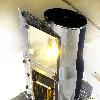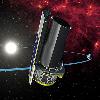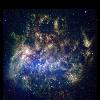

larger Tags: Spitzer Space Telescope View |
also includes NASA s Hubble and Chandra space telescopes Spitzer has explored with unprecedented sensitivity the infrared side of the cosmos where dark dusty and distant objects hide An artist s impression of the Spitzer space telescope For a telescope to detect infrared light essentially heat from cool cosmic objects it must have very little heat of its own Tags: Spitzer Space Telescope View |
The Eternal Life of Stardust Portrayed in New NASA Image Spitzer s infrared view of the Large Magellanic Cloud The blue color seen most prominently in the central bar represents starlight from older stars The chaotic bright Tags: Spitzer Space Telescope View |
|||||||||
The Spitzer Space Telescope (formerly the Space Infrared Telescope Facility, SIRTF) is an infrared space observatory launched in 2003. It is the fourth and final of NASAs Great Observatories (Great Observatories program).
The planned nominal mission period was to be 2.5 years with a pre-launch expectation that the mission could extend to five or slightly more years until the onboard liquid helium supply was exhausted. This occurred on 15 May 2009. Without liquid helium to cool the telescope to the very cold temperatures needed to operate, most instruments are no longer usable. However, the two shortest wavelength modules of the IRAC (#Instruments) camera are still operable with the same sensitivity as before the cryogen was exhausted, and will continue to be used in the Spitzer Warm Mission.
In keeping with NASA tradition, the telescope was renamed after successful demonstration of operation, on December 18, 2003. Unlike most telescopes which are named after famous deceased astronomers by a board of scientists, the name for SIRTF was obtained from a contest open to the general public.
The contest led to the scope being named in honor of Lyman Spitzer, one of the 20th centurys great scientists.Cite weburl=was Lyman Spitzer?accessdate=6 January 2009 work=Nasa: For Educators publisher=California Institute of Technology and the Jet Propulsion Laboratory date=11 March 2004 Though he was not the first to propose the idea of the space telescope (Hermann Oberth being the first, in Wege zur Raumschiffahrt, 1929, and also in Die Rakete zu den Planetenr�umen, 1923), Spitzer (Lyman Spitzer) wrote a 1946 report for RAND describing the advantages of an extra-terrestrial observatory and how it could be realized with available (or upcoming) technology. He has been cited for his pioneering contributions to rocketry and astronomy, as well as "his vision and leadership in articulating the advantages and benefits to be realized from the Space Telescope Program."
The US$ (United States dollar)800 million Spitzer was launched from Cape Canaveral Air Force Station, on a Delta II (Delta II rocket) 7920H ELV rocket, Monday, 25 August 2003 at 13:35:39 UTC-5 (EDT (Eastern Daylight Time)). It follows a rather unusual orbit, heliocentric (heliocentric orbit) instead of geocentric (geocentric orbit), trailing and drifting away from Earths orbit at approximately 0.1 astronomical unit per year (a so-called "earth-trailing" orbit). The primary mirror is 85 cm in diameter, f/12 (F-number) and made of beryllium and was cooled to 5.5 K (kelvin). The satellite contains three instruments that allowed it to perform imaging (astronomical imaging) and photometry (photometry (astronomy)) from 3 to 180 micrometers (micrometre), spectroscopy from 5 to 40 micrometers, and spectrophotometry from 5 to 100 micrometers.
Organization: NASA / JPL / Caltech
Major Contractors: Lockheed Martin,Ball Aerospace (Ball Aerospace & Technologies Corp.)
Alt Names: formerly the Space Infrared Telescope Facility (SIRTF)
Nssdc Id: 2003-038A
Birth Location: Orbiting the Sun
Orbit Type: Heliocentric (Heliocentric orbit)
Period: 1 year
Launch Date: 25 August 2003
Launch Location: Cape Canaveral (Cape Canaveral Air Force Station), Florida
Launch Vehicle: Delta II (Delta II rocket) 7920H ELV
Mission Length: 2.5 to 5+ years ,(For year month dayyear=2003month=08day=25 elapsed)
Wavelength: 3 to 180 micrometer (Micrometre)s
Mass: convert950kglb
Style: Ritchey-Chr�tien
Diameter: 0.85 m (Metre)
Focal Length: 10.2 m
Coolant: Liquid helium
Instrument 1 Name: IRAC
Instrument 1 Characteristics: infrared camera
Instrument 2 Name: IRS
Instrument 2 Characteristics: infrared spectrometer
Instrument 3 Name: MIPS
Instrument 3 Characteristics: far infrared detector arrays
Website: www.spitzer.caltech.edu/



